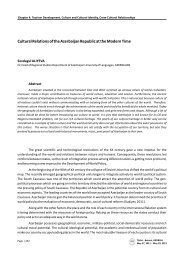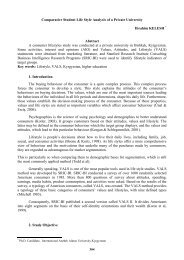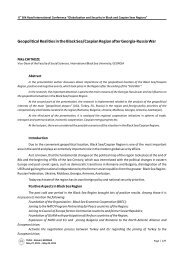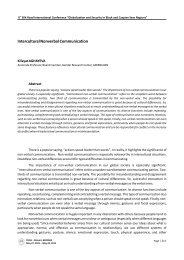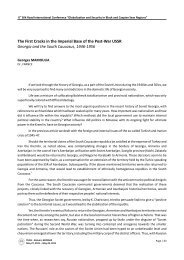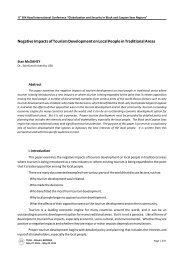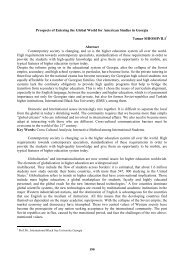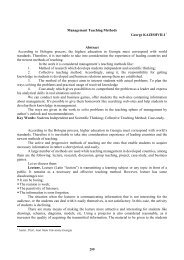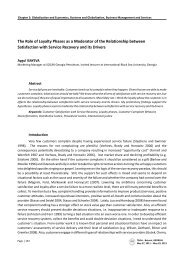Natela POPKHADZE, Honesty is the Best Policy Say No to the ...
Natela POPKHADZE, Honesty is the Best Policy Say No to the ...
Natela POPKHADZE, Honesty is the Best Policy Say No to the ...
Create successful ePaper yourself
Turn your PDF publications into a flip-book with our unique Google optimized e-Paper software.
Chapter 5: Education, Development of Education, Globalization in Education<br />
<strong>Honesty</strong> <strong>is</strong> <strong>the</strong> <strong>Best</strong> <strong>Policy</strong> <strong>Say</strong> <strong>No</strong> <strong>to</strong> <strong>the</strong> M<strong>is</strong>information<br />
<strong>Natela</strong> <strong>POPKHADZE</strong><br />
Member of National Academy Phas<strong>is</strong>i, Tbil<strong>is</strong>i, GEORGIA<br />
Abstract<br />
I shall talk about <strong>the</strong> representation of state, language and ethnic borders of <strong>the</strong> area from <strong>the</strong> Don, <strong>the</strong> Dniepr,<br />
and <strong>the</strong> Crimea in <strong>the</strong> north down <strong>to</strong> <strong>the</strong> south <strong>to</strong> <strong>the</strong> Persian/Arab Gulf being represented in several modern acclaimed<br />
h<strong>is</strong><strong>to</strong>rical maps publ<strong>is</strong>hed on <strong>the</strong> websites in various countries, and <strong>the</strong>ir interpretations by modern authors. Compar<strong>is</strong>on<br />
with both publ<strong>is</strong>hed and unpubl<strong>is</strong>hed maps and texts written by one of <strong>the</strong> most trustworthy archaeolog<strong>is</strong>t, lingu<strong>is</strong>t,<br />
ethnographer, h<strong>is</strong><strong>to</strong>rian Prof. Mose G. Janashvili (1856-1934) will be made. He was a d<strong>is</strong>tingu<strong>is</strong>hed eloquent ora<strong>to</strong>r as well,<br />
was able <strong>to</strong> convey complex aspects of h<strong>is</strong><strong>to</strong>ry and politics in a way that was and still <strong>is</strong> understandable without difficulties. I<br />
recommend <strong>the</strong> use of h<strong>is</strong> basic material for a popular handbook after adding <strong>the</strong> conc<strong>is</strong>e information concerning <strong>the</strong><br />
achievements available after h<strong>is</strong> days <strong>to</strong> th<strong>is</strong> day. I recommend <strong>to</strong> make and <strong>the</strong>n <strong>to</strong> translate such an adapted conc<strong>is</strong>e book<br />
from <strong>the</strong> Georgian/Kartuli language in<strong>to</strong> Engl<strong>is</strong>h, Turk<strong>is</strong>h, French, German, Italian, Arabic etc. languages in order <strong>to</strong> make it<br />
available <strong>to</strong> a large audience. H<strong>is</strong> handbook entitled Is<strong>to</strong>ria Sakartuelosi Uudzvelesi Droidan (The H<strong>is</strong><strong>to</strong>ry of Sakartvelo<br />
from Remote Times) written in <strong>the</strong> Kartuli/<strong>the</strong> Georgian language may form a good bas<strong>is</strong> for a new, modern publication.<br />
Unpubl<strong>is</strong>hed material from h<strong>is</strong> vast archive kept at <strong>the</strong> National Centre of <strong>the</strong> Manuscripts of Georgia in Tbil<strong>is</strong>i and at <strong>the</strong><br />
Museum of <strong>the</strong> Georgian Language will make it even better.<br />
The persons symbol<strong>is</strong>ing <strong>the</strong> country and <strong>the</strong> nation called throughout several millennia by <strong>the</strong> names:<br />
Aia, Kolkheti, Aiakolkheti, Colch<strong>is</strong>, Kardu, Sa-kartu-elo, ki Enguri (land called Enguri) etc. are mostly <strong>the</strong> ancient<br />
king Aieti (Aieetes, Aeetes), h<strong>is</strong> daughter Medea.<br />
Picture 1. Modern statue <strong>to</strong> Medea in Batumi<br />
For a brief period in 1940-1953 <strong>the</strong> fame of <strong>the</strong>se persons was overshadowed by <strong>the</strong> fame of Ioseb<br />
Jughashvili (h<strong>is</strong> adopted nick-name was Stalin given by Vladimir Lenin - from <strong>the</strong> Russian word stal meaning <strong>the</strong><br />
metal steel). The fame of <strong>the</strong> latter has eclipsed in recent decades. He <strong>is</strong> rebuked for being a son of a poor<br />
Page | 274<br />
Tbil<strong>is</strong>i - Batumi, GEORGIA<br />
May 27, 2011 – May 29, 2011
th<br />
6 Silk Road International Conference “Globalization and Security in Black and Caspian Seas Regions”<br />
cobbler and lacking education needed <strong>to</strong> rule any country. King Aieti and h<strong>is</strong> daughter Medea have regained<br />
<strong>the</strong>ir positions. The area of <strong>the</strong>ir activity spread over a great part of land and sea incorporated later in several<br />
Silk Road countries.<br />
Th<strong>is</strong> <strong>is</strong> <strong>the</strong> map of <strong>the</strong> known world in I c. according <strong>to</strong> <strong>the</strong> descriptions written in Greek texts. Pho<strong>to</strong><br />
from <strong>the</strong> Encyclopedia for <strong>the</strong> youth. Par<strong>is</strong> 1967. Vol III: 45.<br />
The countries ruled by Aieti, h<strong>is</strong> s<strong>is</strong>ter Circea, h<strong>is</strong> daughter Medea in <strong>the</strong> II millennium BCE and by later<br />
kings of Aiakolkheti, Kaldea/Chaldea/Kardunia/Kardu encompassed <strong>the</strong> area starting from <strong>the</strong> Aia peninsula<br />
(modern Crimea) in <strong>the</strong> north and spread down <strong>to</strong> <strong>the</strong> ocean in <strong>the</strong> south. Aieti had several capitals in h<strong>is</strong><br />
kingdom. He spent several months in each of <strong>the</strong>m <strong>to</strong> be close <strong>to</strong> <strong>the</strong> population of those areas in order <strong>to</strong><br />
govern <strong>the</strong> area and <strong>the</strong> population decently. The king used <strong>to</strong> travel from one capital <strong>to</strong> ano<strong>the</strong>r <strong>to</strong>ge<strong>the</strong>r with<br />
h<strong>is</strong> court and <strong>the</strong> dignitaries with <strong>the</strong>ir families, servants. Th<strong>is</strong> practice was retained by kings of Sakartuelo, e.g.<br />
by Queen Tamar (XII c.), though her kingdom was not as vast as king Aieti's had been.<br />
The map presented above showing <strong>the</strong> kingdom Karduniash in Mesopotamia <strong>is</strong> drawn by <strong>the</strong> Engl<strong>is</strong>h<br />
scholar Sir Leonard Wooley and <strong>is</strong> printed at <strong>the</strong> end of h<strong>is</strong> book “The forgotten kingdom”(Wooley 1976).<br />
The fame of Medea <strong>is</strong> overshadowed by <strong>the</strong> falsification and abuse of her activity since <strong>the</strong> Greek<br />
author Euripides'(mid IV c. BCE) modification of h<strong>is</strong> own previous text in h<strong>is</strong> play Medea after taking a great<br />
bribe in gold. We know th<strong>is</strong> from <strong>the</strong> text recorded by ano<strong>the</strong>r author in h<strong>is</strong> own publication. The play was<br />
honored with <strong>the</strong> prize no. 3 in Euripides' days. The viewers of that tragedy- h<strong>is</strong> cotemporaries rebuked<br />
Euripides for <strong>the</strong> abuse of Medea. Previous information concerning Medea did not contain material that she<br />
had a bro<strong>the</strong>r called Apsyrtus that she killed because he hindered her escape abroad. Nei<strong>the</strong>r Medea's sons<br />
Tbil<strong>is</strong>i - Batumi, GEORGIA<br />
May 27, 2011 – May 29, 2011<br />
Page | 275
Chapter 5: Education, Development of Education, Globalization in Education<br />
were killed by her or under her command. They were killed after Medea left for ano<strong>the</strong>r country - by <strong>the</strong><br />
Corynthian relatives enraged that <strong>the</strong>ir king and daughter died simultaneously when Medea was at Corynth.<br />
Profs. Akaki Urushadze, Gizo Tchelidze and o<strong>the</strong>r Georgian/Kartueli authors have publ<strong>is</strong>hed papers and books<br />
<strong>to</strong> clarify th<strong>is</strong> problem and inform readers.<br />
It <strong>is</strong> painful and embarrassing for any ethnic Georgian/Kartueli when he/she encounters <strong>the</strong> abuse of<br />
Medea in publications, plays or films. Strabo wrote that <strong>the</strong> word myth meant a real s<strong>to</strong>ry in former centuries<br />
and that it contained much of <strong>the</strong> truth. The Greek authors pra<strong>is</strong>ed Alexander of Macedon. The descriptions of<br />
<strong>the</strong> life and culture in lands conquered by Alexander reveal that he and h<strong>is</strong> people had not seen naphta and did<br />
not know what naphta was. Naphta of <strong>the</strong> kingdom of Media (called now <strong>the</strong> Caspian oil) was called Medea's<br />
naphta even in VI-VII c.c. – after a long time when Medea ruled <strong>the</strong> nearby area; th<strong>is</strong> information <strong>is</strong> recorded in<br />
<strong>the</strong> text written by Justinian - <strong>the</strong> emperor of <strong>the</strong> Eastern Roman Empire. Naphta was used not only as an energy<br />
resource <strong>to</strong> produce heat, but was also used as <strong>the</strong> medication for deseases. Boiled naphta <strong>is</strong> still used in small<br />
portions <strong>to</strong> cure cancer, at least in modern Tbil<strong>is</strong>i.<br />
My recent search in <strong>the</strong> Internet on <strong>the</strong> name Medea delivered a response. One of <strong>the</strong> items was a book<br />
entitled The Medea Hypo<strong>the</strong>s<strong>is</strong>. It has been printed at <strong>the</strong> Prince<strong>to</strong>n University Press in <strong>the</strong> USA in 2009 by <strong>the</strong><br />
author of several popular and science books Peter D. Ward. He <strong>is</strong> a paleon<strong>to</strong>log<strong>is</strong>t at <strong>the</strong> University of<br />
Washing<strong>to</strong>n in <strong>the</strong> USA.He proposed a new hypo<strong>the</strong>ses that <strong>the</strong> planet Earth <strong>is</strong> not <strong>the</strong> loving and caring mo<strong>the</strong>r<br />
for her children, that <strong>is</strong>, <strong>to</strong> <strong>the</strong> humans inhabiting <strong>the</strong> Earth, but on <strong>the</strong> contrary, that she <strong>is</strong> <strong>the</strong> worst mo<strong>the</strong>r of<br />
all that annihilates, kills her children by modification of living conditions, causing d<strong>is</strong>asters, earthquakes,<br />
tsunam<strong>is</strong>, deadly d<strong>is</strong>eases, <strong>the</strong> climate change, famine, lack of food and water, shelter and asylum and etc. The<br />
Good Mo<strong>the</strong>r <strong>is</strong> goddess Gaia of <strong>the</strong> Greek mythology proposed by ano<strong>the</strong>r scholar half a century ago, thus<br />
naming <strong>the</strong> previous <strong>the</strong>ory <strong>the</strong> Gaia Hypo<strong>the</strong>s<strong>is</strong>, while <strong>the</strong> worst mo<strong>the</strong>r that haunts <strong>the</strong> author's imagination<br />
happened <strong>to</strong> be Medea daughter of Aieti/Aieetes king of Colch<strong>is</strong>/Aiakolkheti.Thus <strong>the</strong> scholar wrote that <strong>the</strong><br />
Earth <strong>is</strong> Medea and <strong>is</strong> not Gaia, as previous scholars supposed. P. Ward gave <strong>the</strong> latter <strong>the</strong>ory <strong>the</strong> name <strong>the</strong><br />
Medea Hypo<strong>the</strong>s<strong>is</strong> of <strong>the</strong> Earth, because <strong>the</strong> Greek Euripides wrote a tragedy where Medea killed her two<br />
infant sons in order <strong>to</strong> cause suffer <strong>to</strong> her husband that was going <strong>to</strong> divorce her for <strong>the</strong> Corinthian princess.<br />
Previously <strong>the</strong> s<strong>to</strong>ry of Medea taught that Medea's son Mermeroes became a happy ruler of Corynth and h<strong>is</strong><br />
son Yl succeeded him (Urushadze 1984: 18); Corynth was Aieti's ancestral area <strong>to</strong>ge<strong>the</strong>r with o<strong>the</strong>r areas.<br />
Hence <strong>the</strong> <strong>the</strong>me about <strong>the</strong> killed infant Mermerroes was some later author's invention and addition <strong>to</strong><br />
previously known material. Texts that appeared still later <strong>to</strong>ld that two sons of Medea were killed by <strong>the</strong><br />
Corynthian relatives of <strong>the</strong> king Kreont of Corynth, after Medea flead out of Corynth <strong>to</strong> A<strong>the</strong>ns. Still later<br />
versions d<strong>is</strong><strong>to</strong>rted <strong>the</strong> truth even more and said that Medea killed her small sons Mermerroes and Ferretes and<br />
flead <strong>to</strong> A<strong>the</strong>ns where she married king of A<strong>the</strong>ns and had a son Medes with him. Later time Greek authors,<br />
starting from Sofokles and Euripides became authors of abusive falsifications. In II millennium BCE <strong>the</strong> Sacred<br />
Page | 276<br />
Tbil<strong>is</strong>i - Batumi, GEORGIA<br />
May 27, 2011 – May 29, 2011
th<br />
6 Silk Road International Conference “Globalization and Security in Black and Caspian Seas Regions”<br />
“Golden” Fleece of <strong>the</strong> Sacred Ram=Sheep was considered <strong>to</strong> be <strong>the</strong> bas<strong>is</strong> for <strong>the</strong> abundance, well being of <strong>the</strong><br />
area where it was kept in a sacred place. Th<strong>is</strong> <strong>is</strong> apparent from <strong>the</strong> ritual with <strong>the</strong> Sacred Ram's image and/or<br />
skin described in texts that are in museums, are written in <strong>the</strong> cuneiform script, are translated in<strong>to</strong> Engl<strong>is</strong>h,<br />
French, German and o<strong>the</strong>r modern languages and publ<strong>is</strong>hed in London, Chicago, Berlin, Par<strong>is</strong> etc. These texts<br />
tell that <strong>the</strong> king carried <strong>the</strong> image of <strong>the</strong> ram's hide from one religious center <strong>to</strong> ano<strong>the</strong>r religious center of h<strong>is</strong><br />
kingdom on special days celebrating <strong>the</strong> unity of <strong>the</strong> kingdom. Thus we sea that <strong>the</strong> s<strong>to</strong>ry of <strong>the</strong> Golden Ram has<br />
true h<strong>is</strong><strong>to</strong>rical roots. The author of The Medea Hypo<strong>the</strong>s<strong>is</strong> of <strong>the</strong> Earth was interviewed at <strong>the</strong> Telev<strong>is</strong>ion<br />
Channel 6 in <strong>the</strong> USA. The dialogue <strong>is</strong> available as a video film on <strong>the</strong> Internet that I personally viewed on<br />
January 29, 2011. Viewers and l<strong>is</strong>teners of that Live Edition phoned and d<strong>is</strong>cussed The Medea Hypo<strong>the</strong>s<strong>is</strong>. In<br />
th<strong>is</strong> way P. Ward contributed <strong>to</strong> <strong>the</strong> more wide abuse of <strong>the</strong> Kolkhian/Colchian//Georgian princess Medea.<br />
Euripides's play “Medea” <strong>is</strong> still publ<strong>is</strong>hed in many countries with horrorful covers and <strong>is</strong> staged in various<br />
countries of <strong>the</strong> world with frightful scenes that cause frustration in readers and specta<strong>to</strong>rs.<br />
The Great Campaign ought <strong>to</strong> be started by decent persons against <strong>the</strong> abuse of <strong>the</strong> personality of<br />
Medea – th<strong>is</strong> great healer that had cured many persons out of maladies that were considered fatal in those<br />
days. Due <strong>to</strong> her talant in healing <strong>the</strong> art of healing has been known in honour of Medea; it <strong>is</strong> called Medicine<br />
and <strong>the</strong>re was a term Cura Mediana – Medea's variant of healing <strong>the</strong> persons. To a citizen of <strong>the</strong> USA P. Ward<br />
Medea <strong>is</strong> a mythical princess of Colch<strong>is</strong>. Never<strong>the</strong>less <strong>to</strong> me - <strong>to</strong> <strong>the</strong> itizen of modern<br />
Colch<strong>is</strong>//Georgia//Aiakolkheti//Sakartuelo both Medea and her royal fa<strong>the</strong>r ieti/Aieetes are not mythical<br />
persons at all but are <strong>the</strong> great ancient representatives of <strong>the</strong> Colchian//Georgian//Kartu nation/ethnos. The<br />
ethnos//nation <strong>is</strong> still called eri in our modern language. That word eri <strong>is</strong> so old that it <strong>is</strong> preserved in <strong>the</strong> texts<br />
made four thousand years ago in <strong>the</strong> so called Sumerian and Acadian cuneiform script called Emegir at <strong>the</strong> time.<br />
Th<strong>is</strong> <strong>is</strong> what modern-day famous cuneiform<strong>is</strong>ts publ<strong>is</strong>h and say. Ano<strong>the</strong>r gross abuse of <strong>the</strong> national feelings of<br />
<strong>the</strong> Colchian nation/<strong>the</strong> Kartueli nation/<strong>the</strong> Georgian nation <strong>is</strong> <strong>the</strong> fact of d<strong>is</strong>playing a large white marble statue<br />
made by a German sculp<strong>to</strong>r in about 1840-ies in <strong>the</strong> center of Par<strong>is</strong> in <strong>the</strong> central city park situated beside <strong>the</strong><br />
famous Louvre museum. It depicts a bare Medea wearing only a transparent veil over her legs. She <strong>is</strong> holding a<br />
huge sward and <strong>is</strong> going <strong>to</strong> stab and kill her two tiny sons aged no more than a year. The helplessness of <strong>the</strong> boys<br />
clinging lovingly <strong>to</strong> <strong>the</strong>ir furious mo<strong>the</strong>r makes <strong>the</strong> scene even more frightful. It <strong>is</strong> amazing that <strong>the</strong> authorities<br />
of that park do not realize <strong>the</strong>ir guilt for abusing <strong>the</strong> feelings of passers by, of <strong>the</strong> citizens of Par<strong>is</strong> and of millions<br />
of guests of that central park that stroll <strong>the</strong>re <strong>to</strong> have a rest both physically and emotionally. That marble<br />
monument ought <strong>to</strong> be destroyed and replaced by something appropriate <strong>to</strong> <strong>the</strong> park.<br />
In ano<strong>the</strong>r city of France - in Nantes in <strong>the</strong> archaeological museum <strong>the</strong>re <strong>is</strong> a beautiful picture of Medea<br />
(at least I and my acquaintances consider that <strong>the</strong> depicted lady wearing a crown and a long gown that has <strong>the</strong><br />
embroidered inscription Aia in <strong>the</strong> script used in modern Kolkheti/Sakartuelo/Republic of Georgia as an official<br />
script of th<strong>is</strong> country) painted more than 2600 years ago on a ceramic material; never<strong>the</strong>less it <strong>is</strong> still colorful<br />
with bright fresh-looking paints. The most important fact that appealed <strong>to</strong> me on that painting <strong>is</strong> that <strong>the</strong> lady<br />
Tbil<strong>is</strong>i - Batumi, GEORGIA<br />
May 27, 2011 – May 29, 2011<br />
Page | 277
Chapter 5: Education, Development of Education, Globalization in Education<br />
carries a scepter of freshly cut branch of <strong>the</strong> vine tree. The season <strong>is</strong> <strong>the</strong> autumn as <strong>the</strong> branch has fullgrown<br />
ripe black grapes on <strong>the</strong> <strong>to</strong>p. The tiny piece of wood nailed <strong>to</strong> that branch close under <strong>the</strong> grapes renders it <strong>the</strong><br />
form of a cross. The Scepter of <strong>the</strong> Vine branch with ripe grapes and in <strong>the</strong> form of a wooden cross at that,<br />
reveals that it was a royal symbol of <strong>the</strong> kingdom where Medea ruled and where she was ra<strong>is</strong>ed as a princess of<br />
king Aieti.<br />
Above <strong>is</strong> <strong>the</strong> pho<strong>to</strong> of <strong>the</strong> wig “Medea <strong>the</strong> witch”<br />
H<strong>is</strong><strong>to</strong>rians that publ<strong>is</strong>h books on ancient kingdoms ought <strong>to</strong> explain <strong>to</strong> <strong>the</strong> readers at large, that <strong>the</strong><br />
cross <strong>the</strong> cross <strong>is</strong> depicted on various objects millennia before <strong>the</strong> myth about Jesus Chr<strong>is</strong>t son of Mary and<br />
Joseph was created. There are many archaeological ancient artifacts that prove th<strong>is</strong> fact. The archaeolog<strong>is</strong>ts<br />
have d<strong>is</strong>covered ano<strong>the</strong>r ancient artifact resembling <strong>the</strong> picture of Medea described above. The painters are<br />
unknown as far as I know. Medea's face, features, <strong>the</strong> dress are more meticulously painted on that second<br />
artifact. She attentively gazes at <strong>the</strong> large snake that she has in her hand. Th<strong>is</strong> <strong>is</strong> not a witch but <strong>is</strong> a healer. Hence<br />
it was a sad surpr<strong>is</strong>e <strong>to</strong> me <strong>to</strong> have seen on <strong>the</strong> Internet website of <strong>the</strong> hair ware, that anyone can bye wig with<br />
long curly grey hair called 'Medea <strong>the</strong> witch'. Th<strong>is</strong> <strong>is</strong> one more abuse of <strong>the</strong> memory of <strong>the</strong> most revered lady<br />
ruler of my country. Georgia <strong>is</strong> <strong>the</strong> youngest name of th<strong>is</strong> country; th<strong>is</strong> name Georgia has been known only since<br />
<strong>the</strong> first century of <strong>the</strong> Common Era. Hence <strong>the</strong> most old name Aia ought <strong>to</strong> precede <strong>the</strong> name Georgia, thus<br />
becoming Aiageorgia. Aia ought <strong>to</strong> be duely represented in <strong>the</strong> official name of our republic in every language,<br />
it being <strong>the</strong> most ancient and hence <strong>the</strong> most beloved and prestigious <strong>to</strong> our nation. The name of our nation<br />
'<strong>the</strong> Georgians' (Georgoi) has been used in written sources only since <strong>the</strong> first century CE – by Strabo, Pliny <strong>the</strong><br />
Elder, Tacitus, Popmponius Mela. It referred in <strong>the</strong> first century especially <strong>to</strong> that part of our nation that<br />
inhabited <strong>the</strong> area situated in <strong>the</strong> Aia peninsula that <strong>is</strong> called now <strong>the</strong> peninsula Crimea, also in <strong>the</strong> river<br />
Tana/Tana<strong>is</strong> basin renamed later and known as <strong>the</strong> Don nowadays, also <strong>the</strong> area situated in <strong>the</strong> nor<strong>the</strong>rn part of<br />
<strong>the</strong> large lake in which <strong>the</strong> river Ra (modern name <strong>the</strong> Volga) emptied. In my view <strong>the</strong> Aia population of those<br />
areas were called <strong>the</strong> Georgoi/<strong>the</strong> Georgians due <strong>to</strong> <strong>the</strong> fact that <strong>the</strong> population of <strong>the</strong> areas situated north of<br />
that area were not agricultur<strong>is</strong>ts but were <strong>the</strong> nomads, <strong>the</strong> non-settlers that travelled with <strong>the</strong>ir 'homes' placed<br />
on <strong>the</strong>ir arbs from one area <strong>to</strong> ano<strong>the</strong>r.<br />
King Aieetes of Aia <strong>is</strong> known <strong>to</strong> be <strong>the</strong> son of <strong>the</strong> Sun-god. To <strong>the</strong> modern intellectuals th<strong>is</strong> may seem<br />
absurd. Never<strong>the</strong>less those that have learned <strong>to</strong> some extent <strong>the</strong> cuneiform script and <strong>the</strong> h<strong>is</strong><strong>to</strong>riography of<br />
<strong>the</strong> kings that have been mentioned in <strong>the</strong> texts survived in that script know for certain that '<strong>the</strong> Son of God' was<br />
merely a title of many kings that ruled in <strong>the</strong> third, <strong>the</strong> second, <strong>the</strong> first millennia BCE. Likew<strong>is</strong>e, nowadays <strong>the</strong>re<br />
are persons in various countries of <strong>the</strong> modern world that say and right that Jesus Chr<strong>is</strong>t <strong>is</strong> in <strong>the</strong> skies and <strong>is</strong> <strong>the</strong><br />
only son of <strong>the</strong> God. Millennia ago <strong>the</strong>re were times when th<strong>is</strong> or that king would declare himself God and<br />
adopt <strong>the</strong> title 'God', never<strong>the</strong>less more often <strong>the</strong> kings were content <strong>to</strong> adopt <strong>the</strong> title '<strong>the</strong> son of God'. In some<br />
texts' <strong>to</strong> become God' meant that <strong>the</strong> king died: th<strong>is</strong> text <strong>is</strong> in <strong>the</strong> letter of king Mursill<strong>is</strong> of Khetta written in <strong>the</strong><br />
cuneiform script. He wrote that h<strong>is</strong> fa<strong>the</strong>r became God - he meant that h<strong>is</strong> fa<strong>the</strong>r <strong>the</strong> king of <strong>the</strong> country died.<br />
Page | 278<br />
Tbil<strong>is</strong>i - Batumi, GEORGIA<br />
May 27, 2011 – May 29, 2011
th<br />
6 Silk Road International Conference “Globalization and Security in Black and Caspian Seas Regions”<br />
Persons that write on ancient h<strong>is</strong><strong>to</strong>ry literature ought <strong>to</strong> learn at least <strong>the</strong> basics of <strong>the</strong> texts written in <strong>the</strong><br />
Cuneiform script. Th<strong>is</strong> will give <strong>the</strong>m <strong>the</strong> necessary bakcground of knowledge that will suffice not <strong>to</strong> make<br />
drastic ideological m<strong>is</strong>takes. Ample literature <strong>is</strong> available in Engl<strong>is</strong>h, German, French, Italian, Span<strong>is</strong>h, Check,<br />
Pol<strong>is</strong>h etc. languages treating texts written in <strong>the</strong> cuneiform script. In <strong>the</strong> modern Aiageorgian language <strong>the</strong><br />
handbooks and/or science papers have been printed in recent years dealing with <strong>the</strong> h<strong>is</strong><strong>to</strong>ry and literature of<br />
<strong>the</strong> population that used <strong>the</strong> Cuneiform script - by Profs. Jemal Sharashenidze, Grigol Giorgadze, Zurab<br />
Kiknadze, Levan Gordeziani, Irina Tat<strong>is</strong>hvili, Ana Meskhi, Nino Samsonia, Maia Gambashidze, Erekle<br />
Astakh<strong>is</strong>hvili, Eka Avaliani, Paata Ram<strong>is</strong>hvili, Eduard Menabde as well as by Zurab Qapianidze, Gia Kvashilava<br />
etc. Previously, at <strong>the</strong> start of XX c. texts written in <strong>the</strong> Cuneiform script were analyzed by <strong>the</strong> Aiageorgian<br />
authors: Profs: Ilia Tchavtchavadze, Mose Janashvili, Niko Gurieli-Marr, Mikheil Tsereteli etc. The enchanting<br />
realm of <strong>the</strong> Cuneiform literature studies have revealed many facts of h<strong>is</strong><strong>to</strong>ry and have shed<br />
light on forgotten realities, forgotten persons and <strong>the</strong>ir lives. The enlargement of <strong>the</strong> number of <strong>the</strong><br />
persons involved in <strong>the</strong>se studies will inhance <strong>the</strong> achievements and lead <strong>to</strong> greater<br />
results.<br />
Golden Aries—The Symbol In Georgia According To D<strong>is</strong>coveries<br />
Two artfacts: one in <strong>the</strong> Louvre and ano<strong>the</strong>r in Ambrolauri in Georgia dated 14th c. BC and 18th c. BC<br />
respectively d<strong>is</strong>play ei<strong>the</strong>r <strong>the</strong> Sun bird or <strong>the</strong> falcon with widespread wings. Head of <strong>the</strong> Ram <strong>is</strong> on <strong>to</strong>p of <strong>the</strong><br />
bird on <strong>the</strong>se artfacts. The symbol represents <strong>the</strong> ancient Georgian ideology: as <strong>the</strong> sun entered <strong>the</strong> Aries in<br />
Tropical ecliptic <strong>the</strong> New Year's Day started in spring and <strong>the</strong> forst furrow was made by <strong>the</strong> king, followed by <strong>the</strong><br />
general agricultural work of <strong>the</strong> entire agricultur<strong>is</strong>t class in <strong>the</strong> fields. The artfact in Louvre was excavated in<br />
Egypt and it might belong <strong>to</strong> <strong>the</strong> mo<strong>the</strong>r of faraoth Achen-Aten that introduced <strong>the</strong> mono<strong>the</strong><strong>is</strong>t religion of <strong>the</strong><br />
Sun-d<strong>is</strong>c from h<strong>is</strong> mo<strong>the</strong>r's country in mid-14th century BCE.<br />
Th<strong>is</strong> <strong>is</strong> king Parnavazi's coin <strong>is</strong>sued in III c. BCE. H<strong>is</strong> image faces <strong>the</strong> inscription in Asomtavruli<br />
Kartuli/Georgian: Ke<strong>is</strong>ar Parnavaz, shortened <strong>to</strong> Kei-I Pz.<br />
References<br />
Janashvili M.G., Sakartuelos <strong>is</strong><strong>to</strong>ria, III edition. 1906. Tbil<strong>is</strong>i<br />
Urushadze A., The Country of Medea. 1984. Tbil<strong>is</strong>i. Tbil<strong>is</strong>i University Publ<strong>is</strong>hing House<br />
Bolkhovitdinov E. Georgia// Gruzia. Leipzig. 1804<br />
Ward P.D., The Medea Hypo<strong>the</strong>s<strong>is</strong> of <strong>the</strong> Earth. 2009. Prince<strong>to</strong>n University Press<br />
Tbil<strong>is</strong>i - Batumi, GEORGIA<br />
May 27, 2011 – May 29, 2011<br />
Page | 279



